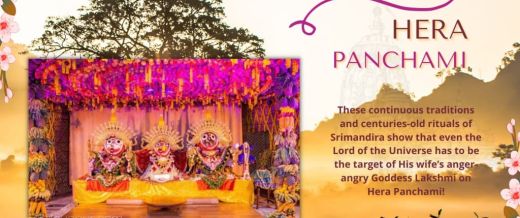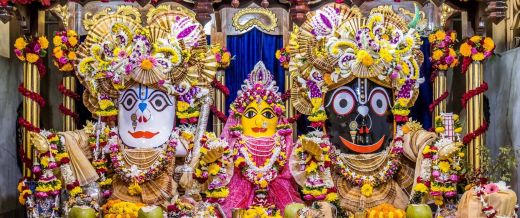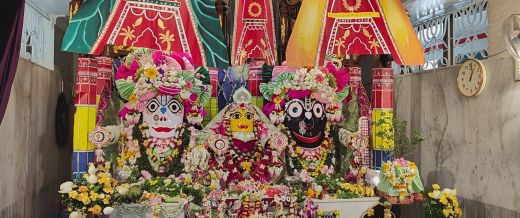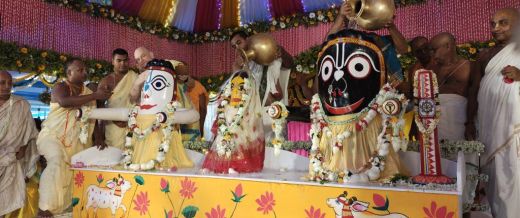


During the Ratha-yātrā festival in Jagannātha Purī, when Lord Caitanya and His party were at the Gundicā Temple, a celebration erupted—with colorful processions, music, and dancing. Svarūpa Dāmodara and others spoke with the Lord near the temple when suddenly the atmosphere shifted.
At that precise joyful moment, Goddess Lakṣmī, the divine consort of Lord Jagannātha, arrived in a majestic procession. Seated upon a resplendent golden four-pillared palanquin adorned with jewels, she led her entourage toward Gundicā—to bring her Lord back home.
Lakṣmī’s Protest and Displeasure
Lakṣmī Devi was deeply displeased. In her eyes, Lord Jagannātha had been taken away by His brother Balabhadra and sister Subhadra too often and for too long, neglecting her affection and participation in the Ratha-yātrā festivities. On this “fifth day” (Panchami), she decided enough was enough—thus the name Hera Panchami (hera = “to see/meet secretly”).
Bearing her anger, she attempted a dramatic act of reclaiming: she symbolically attempted to steal Jagannātha from Gundicā, signifying she wouldn’t let the festival conclude until the Lord returned to her side.
The Turning Point
With determination, Lakṣmī ordered the temple ropes to be cut, seeking to disrupt the pulling of the chariot. Her associates prepared to interfere with the festivities. But Svarūpa Dāmodara and Rūpa Gosvāmī, witnessing her wrath, stepped forward.
They approached Lakṣmī Devi with reverence, speaking tenderly and lovingly to pacify her mind. Their gentle words reminded her of the broader joy of the festival, and with pure devotional respect, they soothed her jealousy and disappointment.
Reconciliation and Departure
Gradually, Lakṣmī Devi’s anger melted away. Comforted by heartfelt assurances and reassured of her deep place alongside the Lord, she relinquished her disruptive act and returned, calm and satisfied, into the temple to resume her worship.
Summary Meaning
Hera Panchami illustrates the mood of Lakṣmī’s deep love and possessiveness for Jagannātha. Even amidst divine pastimes of joy and celebration, when devotion is full and hearts are immersed in worship, attachment arises—and with it, emotion. Lakṣmī’s act symbolizes that intimate, personal bond the devoted feel when separated from their beloved Lord.
Her anger leads to meaningful dialogue and reconciliation, demonstrating how tender mercy reigns even in divine love relationships. It’s a touching vignette of devotional sentiment woven into the Ratha-yātrā lila.
Jai Sri Laxmi Devi Ki Jai!!!!
Sri Ratha Yatra Ki Jai!!!

The Puranas explain why the Supreme Lord, Sri Krishna appears in Puri Dham as Dharu-brahma. King Indradyumna once found three logs of wood in the ocean. Lord Krishna personally came to Indradyumna disguised as Viswakarma in order to carve the deities from the logs. He instructed the king to leave Him alone for twenty-one days inside the room. Viswakarma warned that if anyone opened the door before twenty-one days, the deities carving would remain incomplete.
Fifteen days passed and no sounds of carving could be heard from the room. Queen Gundicha suspected that the old carpenter was dead inside due to want of food. She asked the king to open the door and investigate. The king objected to this proposal, wanting to follow the instruction of the carpenter, but being forced by the queen he opened the door. He was shocked to discover that the carpenter had disappeared. To the king’s sadness, the deities construction was unfinished.
Then one unseen sound vibration was heard. “Do not worry,” the voice said. “Because you opened the door before twenty-one days and did not keep your promise, the deities will remain in this form. You can start worshiping these deities. Bring Lord Brahma from Brahma-loka to install Them.”
From this description it seems that these deities are unfinished or incomplete forms of the Lord. People give many different purports to explain this form of the Lord. Some say that Parabrahma is formless, and that this “incomplete” form of Jagannath proves it. Others say this is the form of the Buddha. Still others claim this form to be Bhairava. To some this form looks very ghastly. Yet many people glorify His lovely features, especially His smiling face. All of these claims are true because He is everything.
There is a very secret and esoteric reason to confirm why Their forms are like this. In fact, Lord Jagannath, Baladeva and Subhadra are not deformed or incomplete forms. Rather, They are eternal forms—super complete forms of the Supreme Personality of Godhead. This form did not manifest just because the queen forced King Indradyumna to open the door prematurely. Actually, the Lord had previously manifested this most beautiful form to His devotees. Choka-dola Lord Jagannath mercifully gives His darshan to everyone in order to deliver the whole universe. The Vaishnavas understand and appreciate this loving reciprocation between the Lord and His devotees, and they relish the following pastime describing the real reason the Lord appears as Jagannath.
After leaving Mathura, Lord Krishna resided in Dwaraka along with His 16,108 wives. All of them were very beautiful and served the Lord with extreme love and care. Though the queens engaged in intense service to satisfy their divine husband, still Lord Krishna always meditated on Sri Vrindavan. He constantly remembered the residents of Vraj, especially the gopas and gopis, and He longingly recalled the pastimes he shared with them. Feeling separation from Vrindavan, sometimes Lord Krishna would seem indifferent to everything. This disturbed His wives immensely. The queens of Dwaraka thought, “What is happening? Even if we serve the Lord so nicely, why does He always talk about and remember Vrindavan?” The Lord frequently cried out in His sleep, “Radhe, Radhe! Gopi, Gopi!”
The queens became curious to know about the Lord’s pastimes in Vrindavan. What happened there so that Lord could not forget? “But who can tell us the childhood pastimes of our beloved husband when he was a child living in Vrindavan?” They came to know that Mother Rohini had witnessed the Vrindavan pastimes of the Lord, and that to their great fortune, she was staying in Dwaraka. One day, all of the queens anxiously approached Rohini mata and requested her to kindly tell them about the Lord’s youth in Vrindavan.
Mother Rohini understood that the queens were eager to hear about the Lord’s Vraja lila. She said, “Indeed, the Vrindavan pastimes of Krishna are very special—so special that Krishna also gets attracted by hearing their glories. I can describe those wonderful activities to you, but on one condition: Krishna and Balaram should not hear when I describe these pastimes. If they hear, it will be a big problem.”
One day, when Krishna and Balaram had gone to attend a meeting in Sudharma meeting hall, all of the queens eagerly took the opportunity of Their absence. They all gathered in one big hall and requested Rohini Mata to narrate Krishna’s childhood pastimes. To make sure that the brothers could not listen, Mother Rohini instructed Subhadra to serve as the door keeper. Subhadra would signal to Mother Rohini if Krishna and Balaram arrived on the scene.
Now everything was ready. All of the queens gathered in great excitement. Subhadra stood at the gate and stretched her hands so that no one could enter inside, specifically Krishna and Balaram. Mother Rohini joyfully told the childhood pastimes of Krishna in Vrindavan. Rohini’s descriptions were so pleasing and ecstatic. The queens heard with rapt attention. They were so absorbed in drinking the amṛta coming from the lips of Mother Rohini that all of them lost their external senses.
Subhadra, although officially engaged in guarding the gate, could not miss the opportunity to hear Lord Krishna’s pastimes. Like the Dwarka queens, she lost her external senses. Although Krishna and Balaram were busy attending a meeting, They could understand that Mother Rohini was describing Their Vrindavan lilas. In overwhelming greed to hear the kotha, the brothers suddenly left the assembly hall and ran to the place where Rohini Devi and the queens were gathered.
When they reached the door, They found Subhadra standing at the gate on security duty. Krishna and Balaram stood on both sides of Subhadra and instantly became absorbed in Mother Rohini’s descriptions. Since Subhadra was fully engrossed in hearing and had lost her external senses, she did not perceive the presence of the Lords. As the three became enraptured by hearing the pastimes, great transformations started to appear in Their bodies. “Oh, such nice pastimes! The Vrindavan pastimes tell of the love and affection of the Vraj basis!” Lost in a state of wonder, Their eyes became big and dilated, and Their hands and legs disappeared inside Their bodies. Their hands and legs shrunken so, Krishna, Balaram and Subhadra looked just like tortoises.
At this time, Narada Muni came to that spot. From a far distance he could see the three forms of Krishna, Balaram and Subhadra. As he approached Them, Krishna, along with His brother and sister came to Their external senses. Their bodies manifested Their normal forms. They wound up that maha-bhava which had manifested Their special forms. Narada Muni danced with his arms raised in great bliss. “I have seen it! I have seen it! You are trying to hide from me. My dear Lord, I have seen so many of Your amazing, transcendental forms. But I have never seen this beautiful form! I humbly pray that You manifest this most auspicious form somewhere so that everyone can take darshan of your most special maha-bhava prakash rupa.”
To fulfill the desire of His devotee, Narada Muni, Lord Krishna manifested this form and eternally resides in Sri Kshetra, Purusottama Dham.
Please visit: https://www.mayapur.com/festivals/Ratha-Yatra for Ratha Yatra Seva to Lord Jagannatha!

Count Down: Day 11 To Ratha Yatra! || Festival Event: June 26th 2025
Before the Ratha Yatra festival in Jagannath Puri, there is a very meaningful event that takes place—Gundicha Marjana. It is the day when Lord Chaitanya Mahaprabhu personally cleaned the Gundicha temple, the place where Lord Jagannath would later reside during His stay away from the main temple.
On this day, Mahaprabhu gathered all His devotees and went with them to the Gundicha temple, carrying brooms, water pots, and great joy in their hearts. The Lord Himself began sweeping, collecting all the dust, straw, and dirt into piles. The devotees were amazed—the Supreme Lord was cleaning with His own hands, and He was doing it with so much love and care.
Everyone followed Him, working together, fully engaged in the service. The Lord then brought water to wash the temple. The walls, floors, ceilings—everything was washed clean. Mahaprabhu even used His own cloth to wipe areas that needed more attention. He would gently correct anyone who missed a spot, not with pride, but with deep affection, teaching everyone the mood of true service.
By the end of the day, the temple was completely clean, cool, and bright. But it wasn’t just the temple that had been cleansed. In truth, everyone’s hearts were being cleaned, too.
This whole event is deeply connected to the verse from Śrī Śikṣāṣṭakam:
ceto-darpaṇa-mārjanam
“Cleansing the mirror of the heart…”
Just as the temple was cleansed to receive Lord Jagannath, our hearts must also be cleansed so that the Lord may reside there. The dust in the temple represents the many unwanted things in our hearts—false pride, selfishness, envy. Mahaprabhu showed us that cleaning with our hands can lead to cleaning within, and that even the most ordinary task becomes sacred when done with love and sincerity.
Gundicha Marjana is not just a festival of cleaning—it is a festival of purification, of learning humility through service. And the most beautiful part is that the Lord Himself showed us how to do it.
So every time we pick up a broom, every time we clean something in the Lord’s service, let us remember this sweet pastime—when the Lord became a sweeper and showed the world the glory of simple, heartfelt service.
To serve on this day please visit: https://www.mayapur.com/festivals/Gundica-Marjana

Yesterday we celebrated the ever-merciful Snana Yatra of Lord Jagannatha, and what an outpouring of love it was! Truly, the Lord is Bhavagrahi Janardana — the One who accepts the devotion in our hearts far more than any external offering. Who could be more merciful, more reciprocal, more captivating than Him? Just after the glorious Darshan Arati, Lord Jagannatha, along with His dear brother Baladeva and sister Subhadra Devi, ascended Their Snana Mandap — the bathing platform — where They received an unending Abhishek from thousands of longing, love-filled hearts. For over 5 hours, devotees poured water, love, and prayers upon the Supreme Lord who stood there gracefully, accepting all offerings without discrimination. Jagannatha’s mercy knows no boundaries.
The Skanda Purana proclaims: — "I do not consider one’s sin or piety, family or birth. Whoever worships Me with love is very dear to Me." Just look around — villagers, pilgrims, children, elders, near and far — they all came together, united by the sheer pull of the Lord of the Universe. He draws the soul, not by force, but with those huge lotus eyes, reminding us that we are never too unqualified to approach Him. The Abhishek ceremony isn’t just a ritual — it is an act of surrender. Bathing the Lord on this day is said to wash away lifetimes of sins, open the heart, and awaken dormant love for Krishna. It is said that the Snana Yatra is the only time the Lord accepts such public bathing, allowing each of us to come face-to-face with His humility and compassion.
Alongside, prasadam flowed endlessly — lovingly cooked and distributed to tens of thousands of devotees, visitors, and guests who gathered to honor our dearest Lord on this auspicious day of His appearance in this majestic form. And now, having accepted all our offerings and sins, Lord Jagannatha will rest for 15 days — this period is known as Anavasara. During this time, the Lord enters a private chamber to "recover", but really, He is entering our hearts, preparing them to receive a spark of pure love for Him. But don’t worry — He’s coming back! And not quietly! The grandest parade — Ratha Yatra — will begin soon from 27th June to 5th July! Jagannatha will once again come out in His chariot to bless the world.
If you missed the chance to serve during Snana Yatra, this is your golden opportunity! Come join the service of the Lord of the Universe as He takes to the streets with His siblings. There are many sevas waiting, and every little effort is seen and loved by the Lord.
Come pull the chariot of your heart closer to Him. Come serve Jagannatha, Baladeva, and Subhadra Devi in Their divine journey!
Sponsor a Seva: https://www.mayapur.com/festivals/Ratha-Yatra

